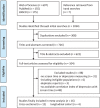Dose-response association of screen time-based sedentary behaviour in children and adolescents and depression: a meta-analysis of observational studies
- PMID: 26552416
- PMCID: PMC4977203
- DOI: 10.1136/bjsports-2015-095084
Dose-response association of screen time-based sedentary behaviour in children and adolescents and depression: a meta-analysis of observational studies
Abstract
Background: Depression represents a growing public health burden. Understanding how screen time (ST) in juveniles may be associated with risk of depression is critical for the development of prevention and intervention strategies. Findings from studies addressing this question thus far have been inconsistent. Therefore, we conducted a comprehensive systematic review and meta-analysis of data related to this question.
Methods: The meta-analysis was conducted in accordance with the PRISMA guideline. We searched the electronic databases of PubMed, Web of Science and EBSCO systematically (up to 6 May 2015). OR was adopted as the pooled measurement of association between ST and depression risk. Dose-response was estimated by a generalised least squares trend estimation.
Results: Twelve cross-sectional studies and four longitudinal studies (including 1 cohort study) involving a total of 127 714 participants were included. Overall, higher ST in preadolescent children and adolescents was significantly associated with a higher risk of depression (OR=1.12; 95% CI 1.03 to 1.22). Screen type, age, population and reference category acted as significant moderators. Compared with the reference group who had no ST, there was a non-linear dose-response association of ST with a decreasing risk of depression at ST<2 h/day, with the lowest risk being observed for 1 h/day (OR=0.88; 95% CI 0.84 to 0.93).
Conclusions: Our meta-analysis suggests that ST in children and adolescents is associated with depression risk in a non-linear dose-response manner.
Keywords: Adolescent; Depression; Physical activity; Psychology; Sedentary.
Published by the BMJ Publishing Group Limited. For permission to use (where not already granted under a licence) please go to http://www.bmj.com/company/products-services/rights-and-licensing/.
Conflict of interest statement
statement The authors declare that no conflict of interest exists.
Figures




References
-
- Rideout VJ, Foehr UG, Roberts DF. Generation M [superscript 2]: Media in the Lives of 8-to 18-Year-Olds. Henry J Kaiser Family Foundation 2010. http://kff.org/other/event/generation-m2-media-in-the-lives-of/ (accessed 20 Jan 2010).
Publication types
MeSH terms
Grants and funding
LinkOut - more resources
Full Text Sources
Other Literature Sources
Medical
